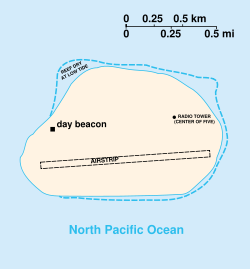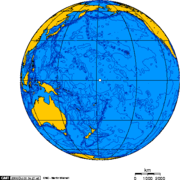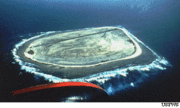Baker Island
2008/9 Schools Wikipedia Selection. Related subjects: Geography of Oceania (Australasia)
Baker Island is an uninhabited atoll located just north of the equator in the central Pacific Ocean about 3,100 km (1,670 nmi) southwest of Honolulu. The United States took possession of the island in 1857. The island is almost half way between Hawaii and Australia. Its nearest neighbour is Howland Island 68 kilometers to the north.
Baker Island National Wildlife Refuge consists of the 405 acre (164 ha) island and a surrounding 30,500 acres (123 km²) of submerged land. The island is now a National Wildlife Refuge managed by the U.S. Fish and Wildlife Service as an insular area under the U.S. Department of the Interior. Baker Island is an unincorporated and unorganized territory of the U.S..
Its defense is the responsibility of the United States; though uninhabited, it is visited annually by the U.S. Fish and Wildlife Service. For statistical purposes, Baker is grouped with the United States Minor Outlying Islands.
History
Baker was discovered in 1818 by Captain Elisha Folger of the Nantucket whaling ship Equator, who called the island "New Nantucket". In August 1825 Baker was resighted by Captain Obed Starbuck of the Loper, also a Nantucket whaler. The name goes back to Michael Baker, who visited the island in 1834. Other references state that he visited in 1832, and again on August 14, 1839 in the whaler Gideon Howland, to bury an American seaman.
The United States took possession of the island in 1857, claimed under the Guano Islands Act of 1856. Its guano deposits were mined by the American Guano Company from 1859 to 1878. John T. Arundel and company, a British firm, made the island its headquarters for its guano digging operations in the Pacific from 1886 to 1891. In 1935, a short-lived attempt at colonization was begun.
The American colonists were landed from the Itasca, the same vessel that brought colonists to neighboring Howland Island, on April 3, 1935. They built a lighthouse, substantial dwellings, and attempted to grow various plants. One sad-looking clump of coconut palms was jokingly called "King-Doyle Park" after two well-known citizens of Hawaii, who were on the Taney in 1938. The clump was the best on the island, planted near a water seep. The dry climate and sea birds, eager for anything upon which to perch, do not give trees or shrubs much chance to get started.. King-Doyle Park was later adopted as a geographical name by the USGS.
The settlement Meyerton had a population of four American civilians, evacuated in 1942 after Japanese air and naval attacks. During World War II it was occupied by the U.S. military.
Since the war, Baker has been uninhabited. Feral cats were eradicated from the island in 1964. Public entry is by special-use permit from U.S. Fish and Wildlife Service only and generally restricted to scientists and educators.
Geography
Located in the North Pacific Ocean at , the island is tiny at just 1.64 km² (405 acres) and 4.8 km of coastline. The climate is equatorial, with little rainfall, constant wind, and strong sunshine. The terrain is low-lying and sandy: a coral island surrounded by a narrow fringing reef with a depressed central area. The highest point is 8 meters above sea level.
There are no natural fresh water resources. The island is treeless, with sparse vegetation consisting of grasses, prostrate vines, low growing shrubs, and some scattered ruins. A cemetery and remnants of structures from early settlement are located near the middle of the west coast. The island is primarily a nesting, roosting, and foraging habitat for seabirds, shorebirds, and marine wildlife.
The U.S. claims an exclusive economic zone of 200 nautical miles (370 km) and territorial sea of 12 nautical miles (22 km).
During the 1935–1942 colonization attempt the island was most likely on Hawaii time, which was then 10.5 hours behind UTC. Being uninhabited the island's time zone is now unspecified, but it lies in waters whose nautical time zone is 12 hours behind UTC.

Transportation
There are no ports or harbors, with anchorage available only offshore. There is one boat landing area along the middle of the west coast. There is an abandoned World War II runway, 1,665 meters (5,463 ft) long, which is completely covered with vegetation and unusable.
Natural hazards: The narrow fringing reef surrounding the island can be a maritime hazard and there is a day beacon near the middle of the west coast.
Similarly named islands
- Baker's Island, Mass.
- Baker Island - Acadia Nat. Park, Maine


